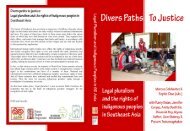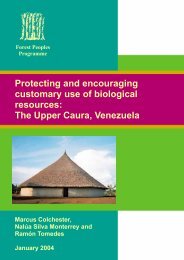Thematic Review II.2: Dams, Indigenous Peoples and Ethnic Minorities
Thematic Review II.2: Dams, Indigenous Peoples and Ethnic Minorities
Thematic Review II.2: Dams, Indigenous Peoples and Ethnic Minorities
You also want an ePaper? Increase the reach of your titles
YUMPU automatically turns print PDFs into web optimized ePapers that Google loves.
<strong>Dams</strong>, <strong>Indigenous</strong> <strong>Peoples</strong> <strong>and</strong> <strong>Ethnic</strong> <strong>Minorities</strong> 23<br />
Cree people, their economies <strong>and</strong> the wildlife resources upon which they depend,” relying on “an<br />
environmental <strong>and</strong> social impact assessment <strong>and</strong> review procedure established to minimize the<br />
environmental <strong>and</strong> social impact of development when negative on the native people <strong>and</strong> the wildlife<br />
resources of the territory.” However, according to the Cree:<br />
“The promised regime to deal with the social impacts <strong>and</strong> opportunities <strong>and</strong> to craft<br />
environmental regulation specific to the Territory has not been implemented…. Rather than<br />
an upst<strong>and</strong>ing, forthright <strong>and</strong> honest fulfilment of these commitments to the Cree people, we<br />
have seen 23 years of attempts by Canada <strong>and</strong> Quebec <strong>and</strong> their entities to deny, diminish<br />
<strong>and</strong> refuse to work with the Cree people …” 107<br />
Indeed, despite the guarantees in the JBNQA, some 5,000 square kilometres of forest have been clearcut<br />
in the Cree territory without any assessment whatsoever of its environmental or social impact. 108<br />
2.1.6 Secondary Displacement <strong>and</strong> Conflict<br />
The appropriation or loss of l<strong>and</strong> <strong>and</strong> other resources due to dam projects is not restricted to the areas<br />
directly impacted by dams. <strong>Indigenous</strong> groups <strong>and</strong> ethnic minorities outside the area may also find<br />
their l<strong>and</strong> <strong>and</strong> other resources expropriated for associated industrial or agricultural projects or for the<br />
resettlement of those relocated by dams. Such groups are not generally considered as project affected<br />
peoples <strong>and</strong> their rights are frequently abused.<br />
In the case of the Maheshwar Dam in India, now under construction, l<strong>and</strong> earmarked for resettlement<br />
sites is currently being used by ethnic minority dalits <strong>and</strong> indigenous adivasi groups. As Heffa<br />
Schucking reports:<br />
“The resettlement site for Jalud is at a location called ‘Samraj’ . . . [Those living there]<br />
explained to me that, while they were never well off, their situation has become desperate since<br />
April 1998. At this time, representatives of [the dam developers] entered the village with a<br />
police force <strong>and</strong> forcibly annexed <strong>and</strong> bulldozed the l<strong>and</strong> of 34 families as well as the entire<br />
pasture l<strong>and</strong> of the hamlet. Although all of these families have either l<strong>and</strong> titles (which I was<br />
shown) or the status of long-term encroaches (<strong>and</strong> the receipts to back this claim), there was no<br />
due process of l<strong>and</strong> acquisition or even written notices served. Instead from one day to the next,<br />
their l<strong>and</strong> was bulldozed <strong>and</strong> taken from them. When some individuals attempted to peacefully<br />
intervene <strong>and</strong> explained that they own title to this l<strong>and</strong>, the police responded by man-h<strong>and</strong>ling<br />
these people <strong>and</strong> the representatives of MPEB threatened to have the entire hamlet thrown into<br />
jail.<br />
“The consequences of these events for the Harijan/Adivasi community are catastrophic. Since<br />
they lost their entire pasture l<strong>and</strong>s they were forced to sell almost all of their cattle <strong>and</strong><br />
buffaloes – some 400 animals. On the private <strong>and</strong> encroached l<strong>and</strong>s that were taken, they had<br />
been growing subsistence crops such as sorghum. Anokibai, a Bhil adivasi, asks: ‘If the l<strong>and</strong><br />
has gone, then we are also gone. If we don’t have the l<strong>and</strong>, will we then eat stones or pebbles<br />
How will we live <strong>and</strong> how will we eat” 109<br />
Through displacing one community to resettle another, dam-based development strategies have thus<br />
often resulted in a spiral of displacement which goes far beyond the actual submergence area of<br />
individual dams. Moreover, the pressure on l<strong>and</strong> in the resettlement areas can be a major cause of l<strong>and</strong><br />
disputes, which often takes the mantle of “ethnic” conflict.<br />
The US-funded Kaptai hydropower dam in the Chittagong Hill Tracts (CHT) in south-east<br />
Bangladesh, for example, displaced more than 100,000 Chakma people – one sixth of the total<br />
Chakma population – <strong>and</strong> flooded around two fifths of their cultivatable l<strong>and</strong>. Some 40,000 of those<br />
displaced left for India <strong>and</strong> today live in Arunachal Pradesh. They have never gained citizenship for<br />
themselves or for their children born in India. A further 20,000 are supposed to have moved into<br />
Arakan in Burma. Others were dispersed within the CHT. As government officials acknowledge, the<br />
resulting l<strong>and</strong> shortage <strong>and</strong> resentment of the government contributed to the bloody conflict between<br />
This is a draft working paper of the World Commission on <strong>Dams</strong>. It was prepared for the Commission as part of its information-gathering<br />
activity. The views, conclusions, <strong>and</strong> recommendations are not intended to represent the views of the Commission.

















